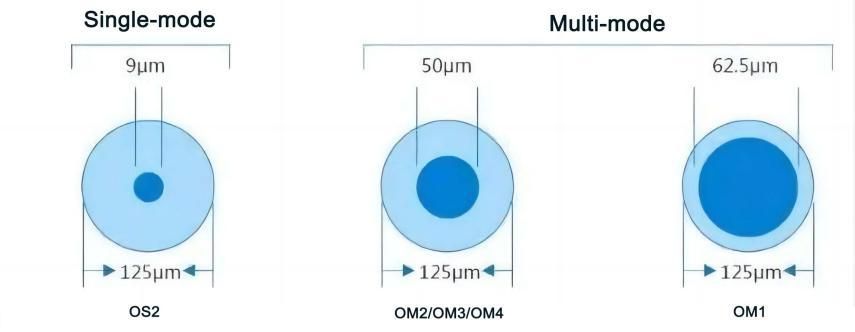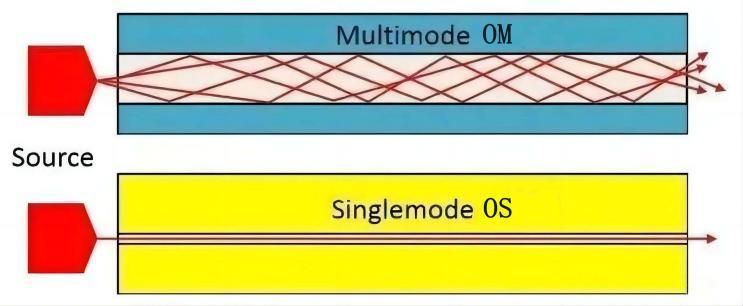Fiber optic cables play a crucial role in telecommunication networks constructions, there are two types of common fiber optic cables in market. One is single-mode and another one is multi-mode fiber optic cable. Usually multi-mode is prefixed with “OM(Optical multi-mode fiber)” and single-mode is prefixed with “OS(Optical single-mode fiber)”.
There are four types of multi-mode: OM1, OM2, OM3 and OM4 and Single-mode has two types of OS1 and OS2 in ISO/IEC 11801 standards. What is the difference between OM and OS2 fiber optic cables? In the following, we will introduce the difference between two type of cables.
1.The difference in core diameter and fiber types
OM and OS type cables has big difference in core diameter. Multi-mode fiber core diameter is 50 µm and 62.5 µm typically, but OS2 single-mode typical core diameter is 9 µm.
Optical Fiber Core Diameters
Fiber types
2.The difference in attenuation
The attenuation of OM cable is higher than OS cable, because of larger core diameter. OS cable have narrow core diameter, so the light signal can pass through fiber without reflected to many times and keep the atenuation to minimum. But OM cable has bigger fiber core diameter which means it will losse more light power during light signal transmission.
3. The difference in distance
The transmission distance of single-mode fiber is not less than 5km, which is generally used for long-distance communication line; while multi-mode fiber can only reach about 2km, and it is suitable for short-distance communication in buildings or campuses.
|
Fiber type |
Distance |
||||||
|
100BASE-FX |
1000BASE-SX |
1000BASE-LX |
1000BASE-SR |
40GBASE-SR4 |
100GBASE-SR10 |
||
|
Single-mode |
OS2 |
200M |
5KM |
5KM |
10KM |
— |
— |
|
Multi-mode |
OM1 |
200M |
275M |
550M (Need mode conditionning patch cord) |
— |
— |
— |
|
OM2 |
200M |
550M |
— |
— |
— |
||
|
OM3 |
200M |
550M |
300M |
100M |
100M |
||
|
OM4 |
200M |
550M |
400M |
150M |
150M |
||
4. Difference in wavelength & Light Source
Compare to OS cable, OM cable has better “light-gathering” capacity. The larger size fiber core allow the use of lower-cost light sources, like LEDs and VCSELs operating at 850nm and 1300 nm wavelengths. While OS cable mainly operate at 1310 or 1550 nm wavelengths which require more expensive laser sources.
5. Difference in bandwidth
OS cable supports brighter and more power light sources with low lower attenuation, provides theoretically unlimited bandwidth. While OM cable relies on the transmission of multiple light modes with less brightness and higher attenuation which gives limittation on bandwidth.
6. Difference in cable color sheath
Refer to TIA-598C standard definition , singl-mode OS cable usually coated with yellow outer jacket, while multi-mode cable coated with oragen or aqua color.
Post time: Jan-30-2023










